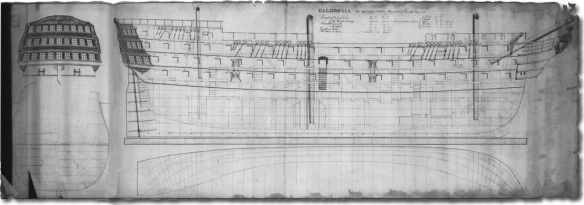A further 100-gun ship was ordered in 1794 to Sir William Rule’s design, and Caledonia was laid down on the first day of 1805 on the slipway recently vacated by the Hibernia. Earlier it had been decided to make her carry 120 guns, and the Surveyor amended his design to this effect. This draught shows the ship as completed, and is notable for the first appearance of the built-up or ‘round’ bow in a First Rate; even the traditional flat stern is more upright, and she has solid barricades along the upperworks. She was altered in the late 1820s, when she was widened, given a circular stern, and acquired a more uniform ordnance of 32-pounder guns on all three decks. Initially 63cwt guns were supplied for the lower deck, but this weight made her lower gunports too close to the waterline, and in 1831 the Admiralty instructed them to be replaced by ones of 55cwt. At the same time her galley was moved up to the upper deck, and her sick berth moved up to the middle deck.
In November 1794 a new First Rate was ordered for the Royal Navy. Although it was at first intended that she should be a 100-gun ship, Rule’s design was eventually altered to make her a 120-gun ship, the largest warship yet built for the British, measuring over 2600 tons. Later alterations saw nearly a foot added to her planned breadth, raising her size to over 2700 tons. With the urgent need for smaller battlefleet ships, which could be built quicker, she was not laid down until 1805, and was finally launched in June 1808. The Caledonia, as she was named, was an immediate success, widely regarded as the finest First Rate so far built. Most subsequent First Rates followed her design, and its essentials were to be maintained for almost the whole of the remaining sailing era.
Having looked at the way in which the basic concept of the First Rate (and its ordnance) was expanded over the last decade of the eighteenth century, we now need to retrace our steps a little to the start of that decade, and look at other events during that period, particularly the consequences of the fresh war which broke out in 1793. In early 1790 there were five First Rates, each of 100 guns, including the Queen Charlotte, lying finished on the stocks but not yet launched. Each had a complement of 850, which was reduced to 837 from 16 April 1794; eight carronades were added to the Establishment from 19 November 1794 – two 32-pounders (on the forecastle) and six 24-pounders (on the roundhouse). Under construction was a larger three-decker of 112 guns (still with 837 men), while even larger First Rates of 120 guns (and 865 men) were to be built by 1815. The remaining 42-pounders on some vessels’ gundecks began to be replaced by 32-pounders from 1790, although the process continued beyond the turn of the century.
The nominal strength of the Royal Navy was increased by three First Rates captured from the enemy during this time: the Commerce de Marseille, a French 120-gun ship brought away from Toulon in 1793; and two Spanish 112-gun ships captured off Cape St Vincent on 14 February 1797, the Salvador del Mundo and the San Josef (retaining their names). Only the last proved of any real value as a fighting unit, but the Salvador del Mundo was commissioned for a short period of sea service.
On the other side of the balance sheet, the Royal Navy suffered its most grievous loss of the French Revolutionary War on 17 March 1800 when the Queen Charlotte, Lord Keith’s flagship in the Mediterranean, caught fire by accident and eventually blew up off Leghorn. The fire started aft around 6am and burnt for several hours before it became obvious that she was unsaveable. Major efforts by her consorts to save men as they abandoned ship were hampered by the fear of explosion, and some 690 were lost, including her commander, Captain Andrew Todd (Admiral Keith was ashore at the time).
A replacement to the same Hunt design (and repeating the same name) was ordered by Earl Saint Vincent’s incoming Board in July 1801, although the keel for the new ship was not laid down until October 1805 since priority was being given to ships which could be brought into service quickly. She differed little from her predecessor, except to mount a more extensive carronade establishment – fourteen 32-pounder carronades disposed two to the forecastle and twelve on the quarterdeck (reducing the long 12-pounder guns to a single pair of chase guns in each location), and six 18-pounder carronades on the roundhouse deck.
Although not launched until May 1810, the second Queen Charlotte was to have a long career. Following the Napoleonic War, she was re-rated as a 108-gun ship from February 1817. Eventually she was renamed Excellent (on 31 December 1859) as a gunnery training hulk, and was not sold to be broken up until January 1892.
